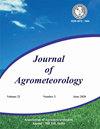在 OTC 条件下,小麦和硬粒小麦品种对二氧化碳和温度升高的响应
Q3 Agricultural and Biological Sciences
引用次数: 0
摘要
2020-2021 年和 2021-2022 年雨季期间,在位于新德里的印度农业研究所(IARI)环境科学部实验场的开顶室(OTCs)内进行了一项实验,以研究小麦(HD 3226)和硬质小麦(HI 8627)品种对升高的温度和二氧化碳浓度的生长和生理反应。结果表明,在温度升高的条件下,小麦的成熟天数加快。小麦品种的光合速率、叶面积指数和分蘖数在温度升高的处理条件下有所降低,而 550 ppm 的二氧化碳浓度升高能够部分补偿光合速率、叶面积指数和分蘖数的降低。在二氧化碳浓度升高加高温的交互作用处理中,小麦品种的蒸腾速率比常温显著降低,而硬粒小麦品种的蒸腾速率不受影响。温度升高对小麦地上生物量的负面影响要大于硬粒小麦。在温度升高条件下,二氧化碳浓度升高可补偿地上生物量的减少,HD 3226(黑麦)减少了 5.9%,HI 8627(硬质小麦)减少了 3.6%。因此,在高温条件下,二氧化碳浓度的升高能够部分补偿小麦品种和硬质小麦品种作物生长的减少。本文章由计算机程序翻译,如有差异,请以英文原文为准。
Response of aestivum and durum wheat varieties to elevated CO2 and temperature under OTC condition
An experiment was undertaken during rabi season of 2020-2021 and 2021-2022 at experimental field of Division of Environmental Science, ICAR-Indian Agriculture Research Institute (IARI), New Delhi inside Open Top Chambers (OTCs) to study the growth and physiological response of aestivum (HD 3226) and durum wheat (HI 8627) varieties to elevated temperature and CO2 concentration. Results showed that days to maturity hastened under elevated temperature condition. Photosynthesis rate, leaf area index and tiller number of wheat varieties reduced in elevated temperature treatment while elevated CO2 concentration of 550 ppm was able to partially compensate the reduction. In aestivum variety of wheat, transpiration rate significantly reduced in elevated CO2 plus high temperature interaction treatment than ambient while transpiration rate of durum variety remained unaffected. The negative effect of elevated temperature on aboveground biomass was more in aestivum variety than durum variety. Elevated CO2 concentration compensated reduction in aboveground biomass by 5.9% in HD 3226 (aestivum) and by 3.6% in HI 8627 (durum) varieties under elevated temperature condition. Hence elevated CO2 concentration will be able to partially compensate reduced crop growth in both aestivum and durum wheat varieties under high temperature condition.
求助全文
通过发布文献求助,成功后即可免费获取论文全文。
去求助
来源期刊

Journal of Agrometeorology
农林科学-农艺学
CiteScore
1.40
自引率
0.00%
发文量
95
审稿时长
>12 weeks
期刊介绍:
The Journal of Agrometeorology (ISSN 0972-1665) , is a quarterly publication of Association of Agrometeorologists appearing in March, June, September and December. Since its beginning in 1999 till 2016, it was a half yearly publication appearing in June and December. In addition to regular issues, Association also brings out the special issues of the journal covering selected papers presented in seminar symposia organized by the Association.
 求助内容:
求助内容: 应助结果提醒方式:
应助结果提醒方式:


